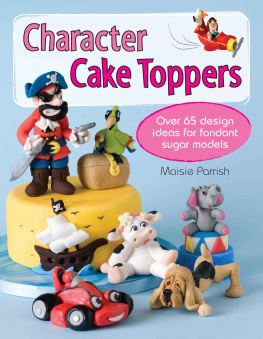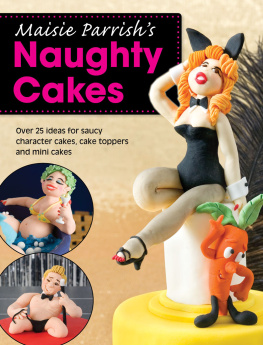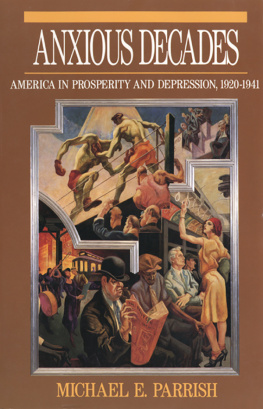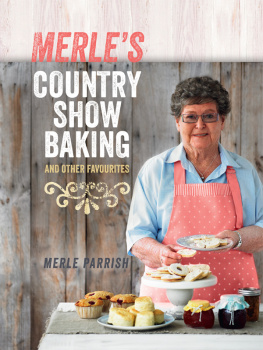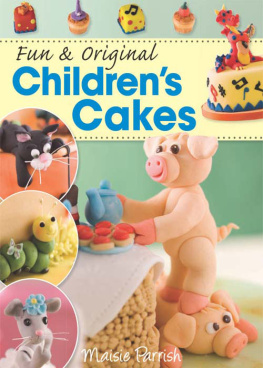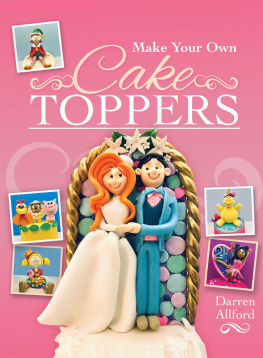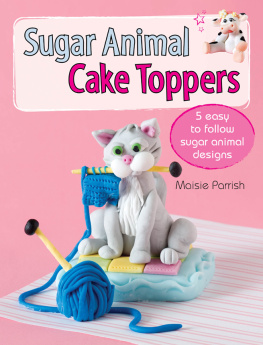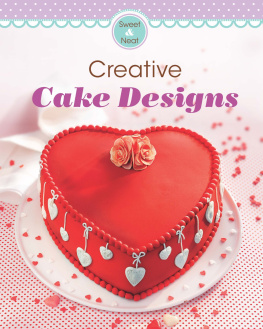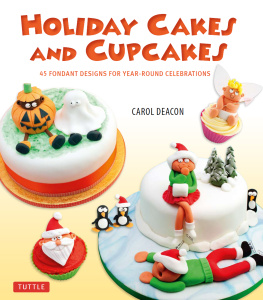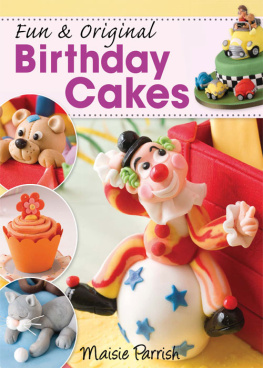Contents
I dedicate this lovely book to a very special lady, Cathy Slatter, for giving so much of her time and endless inspiration.
My thanks also go to Glenda and all the staff at Cakes Around Town, Brisbane, Australia.

IMPORTANT NOTE
The models in this book were made using metric measurements. Imperial conversions have been provided, but the reader is advised that these are approximate and therefore significantly less precise than using the metric measurements given. By means of example, using metric a quantity of 1g can easily be measured, whereas the smallest quantity given in imperial on most modern electric scales is oz. The author and publisher cannot therefore be held responsible for any errors incurred by using the imperial measurements in this book and advise the reader to use the metric equivalents wherever possible.
Introduction
I am very proud and excited to present this new book, packed full of so much material to help and inspire you to create a wonderful range of cake toppers. As always, I have included lots of beautiful photographs and helpful step-by-step instructions just the way you like it. With this in mind, I would like to tell you what makes this book different from any I have written before.

When I teach my workshops, I know from experience that my students are most interested in learning how to make the toppers and many travel from across the globe to do so. Most already know how to cover cakes and boards and want something more, so with this in mind, I hope I have delivered exactly what you are looking for.
There is something here for everyone to indulge in; some projects are very simple, while others are a little more testing, but I know that as you work your way through the book your skills and confidence will grow. Each of the 22 main projects include three separate items, making a total of 66 characters, animals, vehicles and accessories for you to mix and match for numerous occasions. At the back of the book, I have used three of the toppers to demonstrate how you can customize the designs on small or large cakes and bring in elements of the designs to use on boards and mini cakes.
I have discovered while making my toppers that Renshaws white modelling paste is excellent for modelling work and I have used it extensively throughout. I am a great advocate of ready-coloured sugarpaste and there are some beautiful new colours in the Renshaw range to get excited about, perfect for mixing together with the modelling paste when you need to add colour. When a sugarpaste colour is unavailable, I have used Sugarflair paste food colour, which again comes in an amazing colour range. I also enjoyed using Rainbow Dust edible paints, which are water-soluble and look so pretty their pink dust food colour is just perfect for dusting cheeks.
So now its time to enter into the magical world of modelling with Maisie lets make this journey together, and remember everything starts with a ball!
Enjoy, Maisie

Sugarpaste
Sugarpaste is a firm, sweet paste that is very soft and pliable and marks very easily. It is a very adaptable product and when it is used for modelling, especially for body parts or items that need support, we must add CMC (Tylose). All the models in this book are constructed using ready-made modelling paste wherever possible, as this is a most convenient and efficient way to achieve good results. This product does not need to have CMC added to it.
Ready-made sugarpaste
How lucky we are to be able to purchase sugarpaste in so many beautiful colours just take it out of the packet and away you go! Of all the ready-made pastes on the market, the brand leader is Renshaws Regalice (see ) and what a fantastic new range they have for us. The paste is very easy to work with and is of excellent firm quality.

Ready-made packaged sugarpaste is quick and convenient to use. Well-known brands are high quality and give consistently good results.
Tip
Very dark colours, such as black, dark blue and brown, are particularly useful to buy ready-coloured, because if you add enough paste food colouring into white to obtain a strong shade, it will alter the consistency of the paste and make it more difficult to work with.
Note

Instructions for the Gingerbread Man can be found on www.stitchcraftcreate.co.uk
Making your own
While the ready-made sugarpaste is excellent, you can, of course, make your own at home. The bonus of this is that you can then tint your paste to any colour you like using edible paste food colour (see ). This can then be dusted with edible dust food colour to intensify or soften the shade.

Sugarpaste is such a versatile modelling medium, it can be used to create an almost endless variety of cute characters.
Sugarpaste Recipe
900g (2lb) sifted icing (confectioners) sugar
120ml (8tbsp) liquid glucose
15g (oz) gelatin
15ml (1tbsp) glycerine
45ml (3tbsp) cold water
1. Sprinkle the gelatin over the cold water and allow to sponge. Place over a bowl of hot water and stir with a wooden spoon until all the gelatin crystals have dissolved. Do not allow the gelatin mixture to boil.
2. Add the glycerine and glucose to the gelatin and water and stir until melted.
3. Add the liquid mixture to the sifted icing (confectioners) sugar and mix thoroughly until combined.
4. Dust the work surface lightly with icing sugar, then turn out the paste and knead to a soft consistency until smooth and free of cracks.
5. Wrap the sugarpaste completely in cling film or store in an airtight freezer bag. If the paste is too soft and sticky to handle, work in a little more icing sugar.
Quick Sugarpaste Recipe
500g (1lb 1oz) sifted icing (confectioners) sugar
1 egg white
30ml (2tbsp) liquid glucose
1. Place the egg white and liquid glucose in a clean bowl. Add the icing (confectioners) sugar and mix together with a wooden spoon, then use your hands to bring the mixture into a ball.
2. Follow steps 4 and 5 of the Sugarpaste recipe for kneading and storage.
Sugarpaste for modelling
To convert sugarpaste into modelling paste, all you need to do is add CMC (Tylose) powder (see ) to the basic recipe. The quantity needed will vary according to the temperature and humidity of the room, so you may need to experiment to get the right mix depending on the conditions you are working in. As a guide, add roughly 5ml (1tsp) of CMC to 225g (8oz) of sugarpaste and knead well. Place inside a freezer bag and allow the CMC to do its work for at least two hours. Knead the paste well before use to warm it up with your hands; this will make it more pliable and easier to use.

